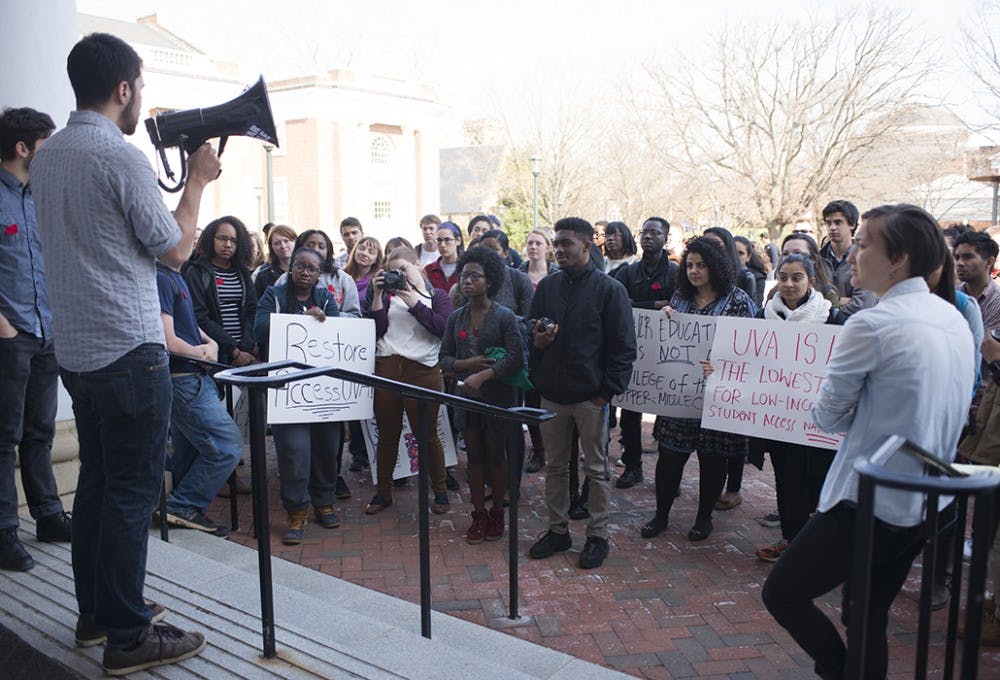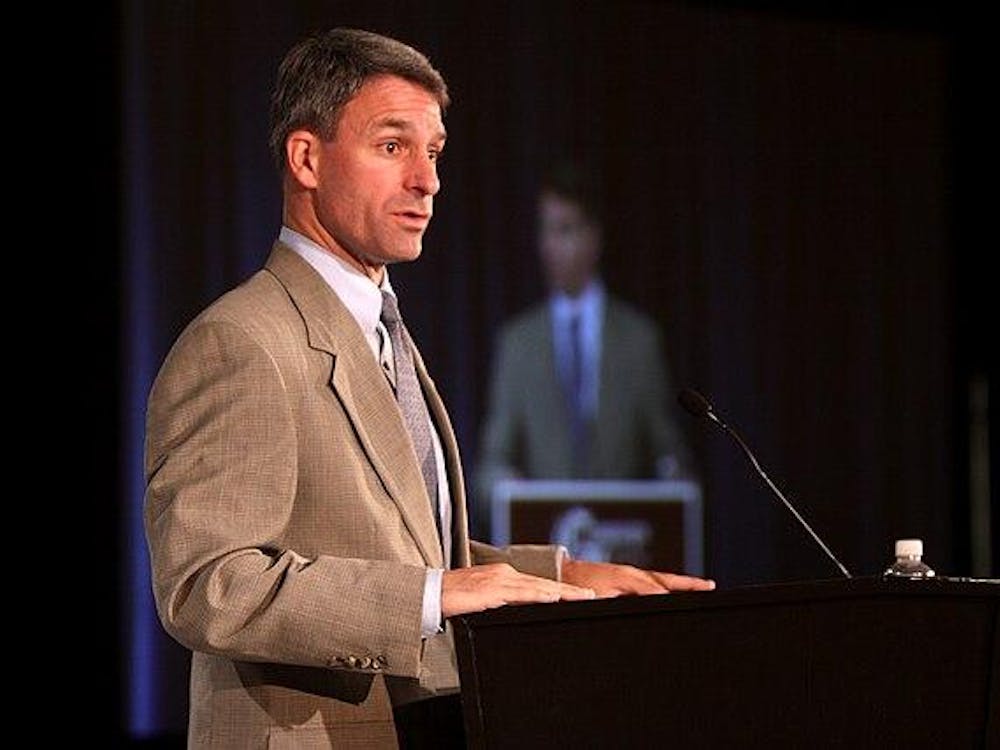In the wake of the University’s approval of a policy limiting protests Finals Weekend, student leaders on Grounds are raising questions about freedom of speech and expression.
The policy, a formalized update of a policy in place for decades, restricts the area protesters can occupy to the area between McCormick Road on one side and Peabody Hall and the Special Collections Library on the other. The policy also limits the use of sound amplification devices and temporary structures.
John Whitehead, a constitutional attorney and president of The Rutherford Institute, criticized the policy in a memorandum.
“Even if there is a reason to forbid demonstrations and protests at certain places on campus at certain times — such as the Lawn during graduation — to forbid expressive activity in all non-designated places at all times — even when crowds might not be large — during Finals Weekend fails to tailor the restriction to the goals of the University,” he wrote.
Final Exercises is not typically a hotbed for disruptive protests — the last time a demonstration interrupted Finals Weekend was about 25 years ago, former University History Officer Sandy Gilliam said. Some students and faculty carried signs during the procession, and were promptly stopped by other students. Based on archival research and consultations with history professors and the University Guide Service, it is likely the protest regarded apartheid and divestment, a significant topic at the time.
“Students grabbed the placards and said, ‘This is our Finals, it’s not yours, you’re not going to mess it up,’ and tore them up on the spot,” Gilliam said.
Jessie Rivera, a fourth-year Engineering student and Fourth Year Trustees’ Final Exercises chair, said she does not anticipate protests to disrupt Graduation Weekend.
Protest demonstrations were “never brought up — no one’s ever made it seem like it’d be a problem,” Rivera said.
The policy will not change how Final Exercises is planned or run, Rivera said.
Rivera said her priorities lie more in ensuring the procession and class party run smoothly and safely for the graduates.
“I just have to plan the Valedictory Exercises on the Friday of Finals Weekend and the class party and solicit the graduation speaker as well,” Rivera said. “The biggest problem was just making sure graduates weren’t too drunk.”
Final Exercises is not a common time for student activism since many students have either left for the summer or are busy with graduation activities, Ian Nakayama, a second-year College student and the outreach chair of the Living Wage Campaign, said.
“I don't think the recent restrictions will affect our group greatly,” Nakayama said. “I don't think usually we plan protests for… graduation, because during graduation most of us are gone for the summer.”
Maria DeHart, a third-year College student and campaign lead for the Climate Action Society’s Divest U.Va. initiative, also said the policy is unlikely to affect any plans for Divest U.Va. The only prominent University events where her organization has demonstrated have been Board of Visitors meetings.
“We don’t think it’s right and we don’t really respect their choice in prioritizing that as a policy, but I don’t think it’ll affect what we do,” she said.
However, DeHart said the University’s addition of protest policies into the University Policy Directory may be reactionary to previous protests, such as those related to tuition hikes and the Black Lives Matter movement.
In December 2014, University students and Black Lives Matter activists protested the dropping of criminal charges against Daniel Pantaleo, an NYPD police officer charged with the fatal choking of Eric Garner.
U.Va. Students United, University students and community members protested against tuition increases at Board of Visitors meetings in March 2015.
There were also several protests against sexual assault following Rolling Stone’s publication of the now debunked article, “A Rape on Campus,” in November 2014.
“We definitely think it’s a breach of freedom of speech and freedom of expression,” DeHart said. “We’re suspicious as to whether the University’s motives are to actually ensure safety during the event or simply to act as a precaution for groups that may be… getting ready to protest.”
Although the policy may not have a significant impact on some organizations, the future of University protest policy is a source of concern among some students.
“Restrictions like this make me nervous for what the University’s going to restrict next when it comes to protesting graduation,” Nakayama said. “We should have the right to protest … that’s part of our First Amendment rights.”
Queer Student Union President Jack Chellman, a third-year College student, said the QSU believes the University did not intend to compromise students’ rights to free speech due to its consistent support of the organization’s activism efforts, such as a chalk campaign against homophobic and transphobic chalk messages last spring.
“Whether or not the administration intends it to be the case, [the policy] ends up limiting student voice and students’ ability to express their opinions,” Chellman said. “I would believe that it’s going to have an impact in some ways, whether or not it’s directly on the QSU this year or next year or the years to come.”
Chellman said the QSU sees the situation as a “miscalculation” about a typically protest-light weekend.
“QSU is understanding this as an issue where student voice and the expression of student opinion is more valuable than limiting disruption at Finals Weekend,” he said.
A University spokesperson declined to offer further comment on the free speech concerns raised by the Rutherford Institute beyond comments made to The Cavalier Daily for its first report about the policy.
Pam Higgins, the University’s executive director of major events, previously told The Cavalier Daily the policy has been in place for decades and was formally reviewed and approved by the Policy Review Committee over the summer.
“The policy continues to ensure the safety and well-being of the University community and the thousands of family and friends that visit Grounds during Finals Weekend,” University Deputy Spokesperson Matt Charles said. “This policy also provides spaces for protests, demonstrations and other expressive activities during Finals Weekends for both the fair and inclement weather plans.”
While many student activist efforts today take place independently of major University events, multiple University protests throughout history took place around Board of Visitors meetings.
A prominent example of a Board of Visitors protest was in March 1987, when protesters staged a sit-in and slept in the Rotunda, where the meeting was taking place. The protest spurred new University policies to decide where protests could and could not take place.
“Some rules were set up then about where you could protest,” Gilliam said. “You couldn’t come in the Rotunda, you were to be on the Lawn side or you could be on the street side, too, you had to be quiet about it, that sort of thing.”
The students were members of the Students Against Apartheid Coalition protesting the University’s selective divestment policy, according to a Cavalier Daily article from the time.
“We as students have a right to be present and to be heard in this closed session of the Board of Visitors during which the divestment issue is discussed,” then-University student and SAAC Co-Coordinator Molly McGarity said during the sit-in.
The University attempted to stave off protesting through a 1987 policy prohibiting the Students Against Apartheid Coalition from constructing shanties near the Rotunda ahead of a Board of Visitors meeting. This policy was struck down by a federal judge after students represented themselves in court against the University.
“The shanties particularized message and the purposes for which the plaintiffs constructed them made it abundantly clear they are a form of expressive symbolic communication that receives protection from the First Amendment,” then-U.S. District Court Judge James Turk said in his ruling.
Students were charged again for trespassing while protesting selective divestment again in April 1990 when another sit-in was staged at the Rotunda. The 31 arrested students were offered the opportunity for charges to drop in exchange for 10 hours of community service through Madison House, the University Police Department or the Office of the Dean of Students.
While the University did not file any disciplinary charges with the University judicial system, it also did not retract its position on the arrests.
“The University bears a special responsibility to protect such a uniquely historical and fragile facility as the Rotunda,” a statement from the University said in April 1990.
The history of University protests has not seen significant changes throughout the years, but varies year to year depending on the issues at hand.
“It comes and goes,” Gilliam said. “You go through a period when there seem to be several groups unhappy about something or the other, and therefore protesting, and then you go through several years where everybody seems content or at least quiet.”
Ibby Han from U.Va. Students United and Bryanna Miller from the Black Student Alliance both declined to comment for this article.
Sumedha Deshmukh from Take Back the Night, Paola Valdez Sanchez from DREAMers on Grounds and the organization email and Facebook page for Alliance for Social Change did not respond for comment.







